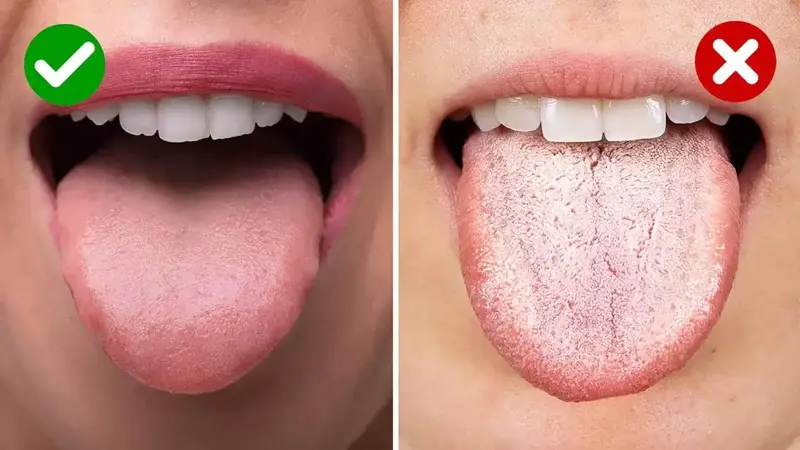Normally pink, your tongue may turn white. Is that bad? What can make the tongue white? How is this treated? Response elements.
The multiple roles of language
The tongue is one of the main organs of the mouth and has multiple functions:
- The taste buds located on the tongue allow it to analyze and recognize foods, as well as their different tastes. The tongue can detect whether a food is edible or not.
- The tongue also contributes to chewing and swallowing food, thanks to its numerous muscles which then come into action.
- The tongue is also one of the organs of speech: depending on its position, its shape and its interactions with the lips and teeth, various sounds can be emitted.
Mobile, soft and particularly muscular, the tongue is divided into three zones:
- The buccal segment: the part of the tongue that you can see when you open your mouth.
- The pharyngeal segment, which is located at the back of the throat.
- The root of the tongue, attached to the hyoid bone which is located in the anterior part of the neck, above the larynx and below the base of the tongue.
White or saburral tongue: why?
Pink and smooth, the tongue can be covered with a more or less thick white deposit, with a relatively “creamy” appearance: we then speak of a white tongue or saburral tongue. This deposit can be removed by rubbing or scraping the tongue. But without treatment of its cause, it quickly reappears afterwards. The white tongue in itself does not correspond to a pathology, but to a symptom with which others can associate.
White tongue: what are the associated symptoms?
Although it is not systematic, saburral tongue or white tongue is generally accompanied by other symptoms:
- A bad taste in the mouth, usually “metallic”
- The feeling of having a “pasty mouth”
- Bad breath (halitosis)
- Taste buds that thicken
- Although rarer, there can also be fever
- As well as inflammation, more or less painful, when swallowing
White tongue: what are the possible causes?
In the case of saburral tongue, this means that bacteria or fungi proliferate within the oral cavity, until they settle on the taste buds. The tongue becomes whiter as oral cell debris accumulates.
White tongue: benign causes
- The main benign cause of a white tongue is poor oral hygiene. The teeth then become covered with bacteria, food debris, acids and sugars that can spread into the oral cavity, making it easier for bacteria to invade the mouth.
- Smoking and regular alcohol consumption can also contribute to poor oral health and therefore facilitate the appearance of white tongue. And this, especially since tobacco, like alcohol, tends to dry out the mouth by reducing saliva production.
- Moreover, dehydration can also lead to the appearance of a white tongue: it is then necessary to rehydrate quickly, by drinking at least 1.5 liters of water per day.
- A deficiency of salts and minerals can also cause this symptom: a balanced diet, rich in fruits and vegetables, is the best way to prevent it.
- White spots can also appear on the tongue, which is referred to as irregular desquamation of the superficial tissues of this organ. Rest assured, this cause is benign and resolves on its own, without treatment.
When white tongue is caused by a fungus
A fungal overgrowth (of a fungus) on the tongue and in the mouth causes a condition called candidiasis, also known as oral thrush. This kind
Mycosis, which can also appear in infants, is caused by the yeast fungus Candida albicans and is manifested by the famous white deposit which can also reach the inside of the cheeks. Taking certain antibiotics or corticosteroids can promote the occurrence of candidiasis, because these medications can unbalance the quantity of bacteria and fungi naturally present in the oral cavity and cause the proliferation of one of them. Other risk factors: the presence of poorly fitted dental prostheses, significant stress, pregnancy or certain gastric pathologies, etc.
White tongue: a sign sometimes warning of more serious pathologies
Certain diseases developing in the digestive system can cause white tongue. This is particularly the case for gastritis, an acute or chronic inflammation of the stomach lining. Diabetes, as well as a liver infection, can also be the cause of the saburral tongue symptom. More serious, the white tongue can also reveal leukoplakia, a possible pre-cancerous sign. This is recognized by the presence of an abnormal white or gray area which forms on the tongue, inside the cheeks or even on the gums. It should be carefully monitored by your doctor. Leukoplakia is further favored by smoking and excessive alcohol consumption. Be careful, in the case of leukoplakia, it is not a deposit, but lesions which cannot be removed by scratching them. A medical consultation is necessary.
White language: what support?
Are you worried about white tongue and the symptoms associated with it? Make an appointment with your GP or dentist. He will then be able to examine you, establish a diagnosis and recommend the most appropriate treatment for the causes of the saburral tongue.
White tongue: treatments for benign causes
If the saburral tongue is the consequence of poor oral hygiene, your dentist must remind you of the essential measures to find it:
- Brush your teeth with a suitable brush and toothpaste for 2 minutes.
- In addition to brushing, you can floss between your teeth.
- Perform this routine at least 30 minutes after each meal.
- Change your toothbrush every 3 months on average, or even sooner if it is damaged.
- Make sure you brush your teeth well.
It is also recommended to quit smoking and moderate your alcohol consumption.
White tongue: what treatments in case of pathology?
To treat candidiasis, good oral hygiene remains the main therapeutic indication. But your doctor may prescribe an antifungal treatment at the same time, to take for a few days to fight this infection. Finally, if the white tongue is caused by an underlying pathology, the treatment will first consist of treating the latter. Thus, in the event of uncomplicated gastritis, generally caused by bacteria, antibiotic treatment will be implemented for around fifteen days. In the case of leukoplakia, the latter is regularly the subject of analyzes and examinations, in order to detect any cancerous development as early as possible.





